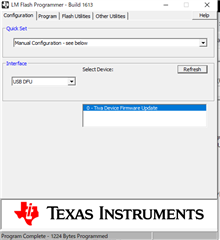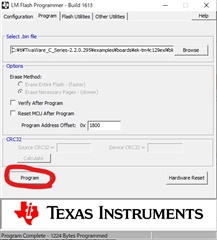Other Parts Discussed in Thread: LMFLASHPROGRAMMER, EK-TM4C129EXL, , UNIFLASH, AWR1843, AWR1843BOOST
Hello, it will be a long time, but I would like to ask you something.
1. Connect the circuit (Fig. 1) that connects TM4C129ENCZADT3 and the USB connector to the PC with a USB cable.
Fig 1
2. I started LMFlashProgrammer.
3. In'Configuration' of LMFlashProgrammer'set as shown in Figure 2.

Fig 2
4. Next, in the Program Tab, set as shown in Figure 3. (The loaded file is the following file.)
C:\ti\TivaWare_C_Series-2.2.0.295\examples\boards\ek-tm4c129exl\blinky\ccs\Debug\brinky.bin

Fig.3
5. If you click the Program button (the part circled), TM4C129ENCZAD will not work.
-------------------------------------------------- -------------------------------------------------- -------------------------------
The reasons for the decision can be raised from the following two points.
(1) Crystal connected to TM4C129
The 16 MHz crystal no longer oscillates.
(2) Display of device manager
Initially, the screen shown in Fig. 4 was displayed, but it disappeared after writing the program.

Fig.4
Is there any cause you can think of?

